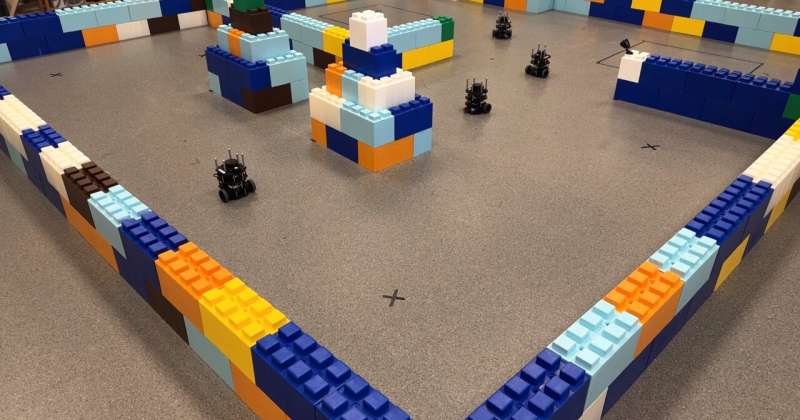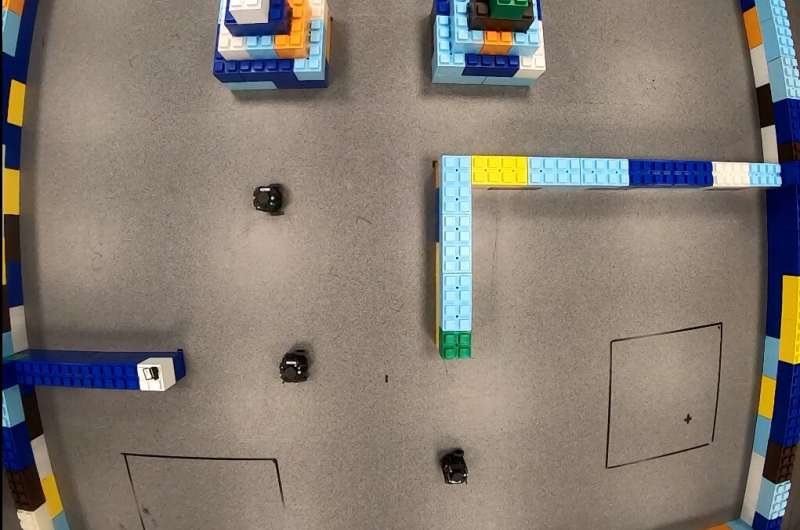May 4, 2023 feature
This article has been reviewed according to Science X's editorial process and policies. Editors have highlighted the following attributes while ensuring the content's credibility:
fact-checked
preprint
trusted source
proofread
An architecture to coordinate the behavior of different robots in a team

When tackling missions as a team, robots should be able to coordinate their efforts, for instance, completing different sub-tasks, monitoring different parts of a target environment, and so on. Over the past few years, computer scientists have therefore been developing computational models designed to coordinate the actions and behaviors of different robots in a team.
Researchers at Lulea University of Technology in Sweden recently introduced a new multi-agent coordination method that integrates an auction-based task with behavior trees, mathematical models often used in computer science to execute plans. This method, introduced in a paper pre-published on arXiv, was found to effectively organize the actions of multiple robots who are working to achieve a common goal, particularly when they are completing tasks that span different stages.
"We found a need for a flexible and reactive task allocation architecture for coordinating multi-agent systems," Niklas Dahlquist, one of the researchers who carried out the study, told Tech Xplore. "I have previously worked with behavior trees and that's why I thought that combining them with a task allocation scheme could result in a flexible framework that also allows for easy integration of new types of tasks and different agents."
The architecture developed by Dahlquist and his colleagues is based on a market-based approach, which underpins the functioning of auctions. Essentially, individual robotic agents in a team estimate the cost related to tackling different sub-tasks that need to be completed, placing "bids" through a central auctioning system. Subsequently, this auctioning system analyzes these "bids" and assigns optimal tasks to each of the agents.
"Our architecture also has a local layer, consisting of a behavior tree, that guides the individual agents to complete an allocated task," Dahlquist explained. "This gives the advantage that there is no need for a centralized unit to have full global knowledge about the system, all that is needed are the bids from the agents and also it reduces the computational burden."

The multi-agent coordination architecture proposed by this team of researchers could have notable advantages over other models proposed in the past that typically rely only on auction theory or behavior teams. By separating task allocation and execution steps, for instance, this approach could be easier to apply to teams that contain robotic agents with different capabilities or to missions that entail very different sub-tasks.
"The most notable takeaway from this work is the integration of behavior trees with the task allocation to allow for incorporating multi-stage tasks," Dahlquist said. "This gives a flexible and scalable architecture for tackling scenarios where the specific tasks are unknown in advance."
Dalquist and his colleagues evaluated their architecture in a series of experiments in their laboratory, using several TurtleBot3 robots. Their findings were very promising, as their method could coordinate the efforts of these robots while they were collectively tackling simple missions.
In the future, this new architecture could be applied and tested in more-complex scenarios, involving different types of robots or a broader range of sub-tasks. In addition, it could potentially inspire the creation of similar approaches for coordinating the efforts of different agents.
"Our future works will focus on incorporating of new types of tasks and introducing heterogeneous agents, such as UAVs, and a more complex coupling between the task allocation and the behavior trees," Dahlquist added. "We are also working towards demonstrating the feasibility by performing larger deployments in more realistic environments."
More information: Niklas Dahlquist et al, Reactive Multi-agent Coordination using Auction-based Task Allocation and Behavior Trees, arXiv (2023). DOI: 10.48550/arxiv.2304.01976
© 2023 Science X Network





















